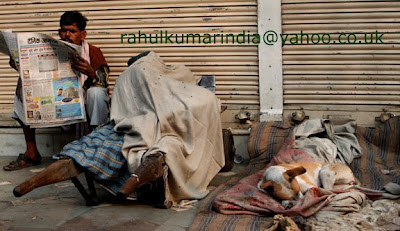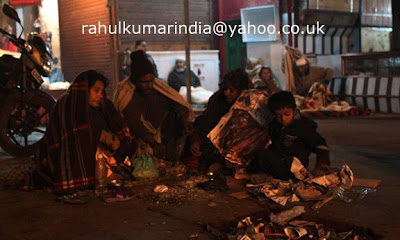A street dog spends a lazy sunny morning in a boat on the Yamuna river bank near the ghats in old Delhi in February 2010.
It is an irony that water and the Indian capital city, Delhi, do not get along very well. This is despite the fact that Delhi is well endowed with numerous sources of water, including the mighty Yamuna river, ponds, lakes and drains that bring water from the higher reaches of the city to the river. It was the presence of the river that attracted kings and rulers to establish their kingdoms here and allowed civilizations to flourish over hundreds of years.
The Rajon ki Boli at the Mehrauli Archaeological Park still gets water even though the groundwater level is depleting fast every year.
The irony is not lost on anyone that both, the presence and also the absence of water, have become a source of misery for Delhiites. In summer months (April-June) it is the usual problem, people not getting water, while immediately after these months in the monsoon (June-August) it is the abundance of water that brings sorrow caused by flooding and related problems – overflowing of sewers, water logging on the roads, and sometimes even the terror of the river inundating the city.
People at the Sanjay Nagar colony in the diplomatic area of Delhi line up their cans early in the morning in November 2009 to store water for the entire day’s use. The whole family is involved in the enterprise of filling up and carrying water.
The dichotomy of water management stands out starkly during the lean summer months and the lush monsoon season. The only common link is that for both of these seasons, our planners neither have a credible solution to implement nor one to offer to the people. Now that we are at the end of March, it is a matter of weeks, maybe even days, before Delhiites wake up to the shortage of water. The media too will report an increase in the number disputes over sharing and collection of water between next-door neighbours.
A boy frolicks as his buffaloes cools off in a pond in the Delhi heat.
Village women wash clothes at a pond near Kishangarh village in south Delhi.
But none of these are problems that cannot be resolved. If one just looks around one does come across success stories. A good example of a cost-effective water solution right in the city is the historical 13th century Hauz Khas lake in south Delhi. The sewage from residential colonies and villages is treated at a water treatment plant and allowed to flow through the Sanjay Van city forest to give it the benefit of natural treatment before it fills up the lake. This also saves the river Yamuna from getting an extra load of sewage.
The Hauz Khas lake on a misty January afternoon. The lake, which had dried up completely a few years back has been filled up with recycled sewage water.
Talking of sewage and the Yamuna, the problems associated with the river stem not as much as from the sewage that is dumped into it than a almost complete lack of water in the river during the leans season. The amount of water that the river gets during the monsoon season is enormous, sometimes even leading to the fear of floods, but all of that water flows away as planners and politicians sit back and think of mega plans instead of harvesting this water, which literally goes down the drain.
A mechanised cleaning of a drain in east Delhi, near the Karkardooma Courts, in the summer of 2009. Wonder how all this solid waste landed here, in a drain?
The nearly two dozen drains in the city can be used to store and harvest rain water but these are on the contrary used to collect sewage from the city's residential colonies and dump it in the river. The drains are also used to dump or are used garbage that should have been collected by the municipal corporation but is instead put in the drain. Contractors take contracts worth crores of rupees for cleaning up the drains of filth which should not have been in there in the first place.
The pond at Lodhi Garden in central Delhi, though not very deep retains its natural beauty and attracts a lot of young people.
A fisherman's tent stands at the periphery of a lake that has been auctioned by the government to a contractor to catch fish. Photo taken in December 2009.
Solutions that involve less spending are brushed aside as these give little gratification and do not have the luxury of kickbacks. On the other hand, the big projects take time to initialise and do not provide a guarantee if these will indeed provide sustainable and lasting solutions. Most of the times, these end up excerbating the problems or end up needing more money. Nothing can be more stark than the example over the cleaning of the river Yamuna on its Delhi stretch. The Municipal Corporation of Delhi Rs 166 crore taken as a grant from the Japan Bank for International Cooperation (JBIC) for cleaning up the river. The river remains as it was but the citizens will end up paying a hefty interest on the grant.
A tourist finds a moment of peace on the Yamuna bank in Noida. Across the bank is the Delhi skyline. Will Delhiites see a day when they can bank upon the river bank for some yoga, fun and relaxation?
Indian governance is also pulled down by the lack of transparency and almost no accountability. Otherwise how could our politicians sitting in Delhi right under the nose of citizens groups and the national media get away with spending huge amounts in the name of sprucing up the river and still not being able to make a dent in the river’s health. Besides the river, the state of our water bodies is not too good either.
A truck dumps debris at the JNU campus close to a water harvesting structure.
If the water bodies are not filled up by unscruplous land sharks or callous construction agencies, these are damaged or allowed to dry up out of sheer negligence. Right now, authorities at the prestigious Jawaharlal Nehru University (JNU) are dumping malba (debris) near one of their water harvesting structures. Similarly, the Neela Hauz pond in Vasant Kunj in South Delhi too is fighting a tough battle for survival as a new bridge constructed over it has damaged it considerably. Bare 300 metres from this lake, a pond was filled up by the local land mafia as it wanted that space for parking vehicles. If Delhi has to quench its thirst, it will have to learn to respect its water bodies and also learn to give a health life to them. These surface water bodies will provide water to the river and also to the residents of Delhi.
A day of tranquility at the Hauz Khas lake.



















